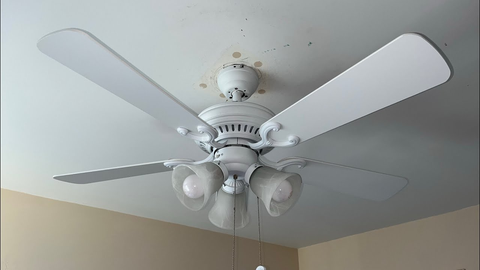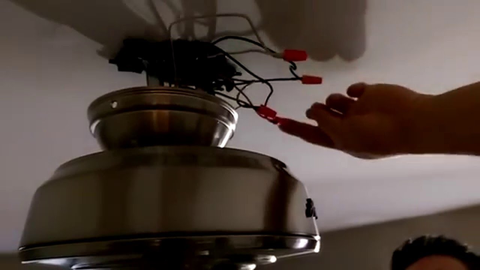
A ceiling fan with light
Resource: https://youtu.be/DIK1M8KwxM4
With ability to cool and light a room, a ceiling fan with light fixtures is one of the most common ways to update the look of your room or outdoor place. However, with many different styles and features for the lighted ceiling fan, it helps to understand it before buying one. Here, you’ll learn all you need to know about this type of fan.
Ceiling Fan and Light
A ceiling fan is primarily meant to push air and provide cooling using what's called the “wind chill factor”. The effect refers to when the air speeds up the evaporation of sweat on your skin, thereby lowering the temperature and making you feel cooler.
Using ceiling fans and lights together adds another function to them, which is providing a source of light. This is often used in bedrooms, living rooms, and outdoor spaces as an energy-efficient way to cool and provide lighting.
Usually, a ceiling fan light fixture comes inbuilt or as a separate add-on kit. The lights attach onto the base of the fan and can found in various styles. This allows for design customization to match that of your home.
What is a Ceiling Fan Light Kit?
A ceiling fan light kit is a type of attachment made to work with the original fan. It will attach directly onto the base and has multiple lighting options, such as LED bulbs, halogen bulbs, or fluorescent bulbs.
The style of the light kit depends on your personal preference. There are traditional lighting fixtures that provide an overall soft light in the room, and there are also modern fixtures that will cast a more directional light.
Can you Replace a Light Fixture with a Ceiling Fan?
Yes, you can easily replace a light fixture with a ceiling fan. You will only need to change the existing wiring so it can support the new load. However, you should always consult an electrician for this type of installation.
The most popular types of ceiling fan light bulbs are LED bulbs, although halogen and fluorescent bulbs may also be used. The type of bulb you choose depends on the style you want and how much energy efficiency you desire.
LED ceiling fan lights offer longer lifespans and higher levels of energy efficiency, plus they run cooler. Halogen bulbs are also an option; they provide a good amount of light and are more affordable than LED bulbs. Fluorescent bulbs can still be used in some instances.

Outdoor ceiling fan with light
Resource: https://youtu.be/EYZjObUYa_4
Indoor/Outdoor Ceiling Fan with Light
A ceiling fan with light can be a type that you can use both indoors and outdoors, or it can be a fan that you can only use indoors. Depending on the situation, you may need to use one or the other. Reasons for that are explained below.
Indoor Ceiling Fan with Light
An indoor ceiling fan with light is meant for use inside the home or other enclosed spaces. These fans do not come with features to resist the elements and should not be used outdoors; they won’t stand up to the conditions, plus you may end up with a dangerous electrical situation.
Outdoor Ceiling Fan with Light
An outdoor ceiling fan with light is designed to work in the elements, such as rain and snow. They have features specifically designed to resist moisture and other environmental factors, so you can enjoy your fan and light all year-round.
When purchasing an outdoor ceiling fan with light, make sure it’s rated for “wet” or “damp” locations. This will ensure that the device is suitable for your environment and can resist the conditions.

White ceiling fan with light
Resource: https://www.youtube.com/watch?v=OxZpLRswso0
Best Ceiling Fan with Light
You can use a lighted ceiling fan in a broad range of spaces, including bedrooms, living rooms, and outdoor patios. The fans will usually come in different styles, from traditional to modern and everything in between. Use these tips to find the best ceiling fan with light for your needs.
- When shopping for a lighted ceiling fan, pay attention to the type of bulb it uses. A ceiling fan with LED light will offer more a higher electrical efficiency, but you can also get halogen and fluorescent bulbs depending on your preference and budget.
- Consider how much air circulation is needed in the space to determine the size of your fan. A larger room will usually require a bigger fan, while a smaller space can use one that is more compact.
- Choose a fan with the right number of blades for your space. The more blades the quieter the fan will be. Other options include a flush mount ceiling fan with light for low hanging ceiling or a downrod type for higher ceilings.4. Don’t forget about the style! A well-chosen ceiling fan and light can be just as much of an accent piece as it is a functional item. Choose a model that complements your home’s design and decor.

Ceiling fan with light installation
Resource: https://www.youtube.com/watch?v=nObLwA2pIUM
How to Install a Ceiling Fan with Light
Whether you are installing a ceiling fan with light for bedroom, family room or patio, there are a few things to consider. Decide on the size and style of fan you want and measure your ceiling height to determine what type of downrod or mounting kit is needed. Below is how to install one:
Ceiling Fan with Light: Installation Instructions
As earlier mentioned, some fans come with their light fixtures, while others do not, and require a separate installation. You may also have an existing electrical box in the ceiling for the fan, or you may need to install one.
Refer to the product instructions and local electrical codes for a new box (which may differ from one region to another), then use these instructions to install your light and ceiling fan.
Installing Ceiling Fan with Light
What you'll need: Step ladder, Voltage tester, Screwdriver, Hand drill, Wire cutter/stripper, and Wire connectors. You’ll also need your ceiling fan, light kit (if not inbuilt), and ceiling fan mounting hardware.
- Start by turning off the power at your breaker box. Using the voltage tester, ensure that the power is off before proceeding.
- Use the drill to make pilot holes for the mounting screws. Run the wires in the electrical box through the fan's mounting plate. Secure the plate in the electrical box using screws.
- Next, assemble the ceiling fan motor, housing, downrod (if it uses one), and canopies. Be sure to run the wires through the motor housing and downrod as needed.
- Secure the fan assembly to the mounting plate. Most fans come with an attachment hook or other means. Next, connect the fan to the ceiling fan wires. The steps to do so are explained below.

Wiring a ceiling fan with lights
Resource: https://www.youtube.com/watch?v=cMyShlNNreY
How to Wire a Ceiling Fan with Light
A ceiling fan with light will normally use one of these wiring configurations: pull chain switch for both fan and light, a wall switch for the light and pull chain for fan, one switch for both light and fan, and two separate wall switches for fan and light. It may also be a remote operated ceiling fan with light.
Before proceeding, it’s important that you understand this concerning the house and ceiling fan wire colors: black is the hot wire that powers the fan, while green is the ground and white the neutral return wire that completes the circuit.
Pull Chain Ceiling Fan with Light
This ceiling fan wiring connection method allows you to control the fan with pull chains, one chain for the fan and the other the motor.
- Connect the fan's green wires to ground wires in the ceiling
- Connect white the fan wires to the white wires
- Next, connect the black and blue wires to the red and black wires of your home's wiring system
Switch and Chain Ceiling Fan with Light
With this wiring setup or configuration, you have one switch to control the light, and a pull chain for the ceiling fan operation.
- Connect the grounding wires(green)
- Connect the white wires
- Identify the light kit blue wire and connect it to the red wire in the ceiling box
- Connect the fan's black wire and the black wire in the ceiling's electrical box
1 Switch Ceiling Fan with Light
The one switch configuration means you will have a single switch to control both the light and the fan at the same time.
- Connect the green wires to ground wires in the ceiling box
- Connect white wires to white wires
- Connect black and blue wire from fan’s motor housing together with black wire from house wiring
2 Switch Ceiling Fan with Light
This ceiling fan wiring option requires two wall switches for the fan and light, allowing for separate operation of each.
- Connect the ground wires (green)
- Next, connect the white wires together
- Connect the fan's blue wire to the red wire in the ceiling box
- Connect the fan's black wire to the black wire
- At the switch box, identify and connect the black wire to the first switch and the red wire to the second switch.
- Finally, connect the green wires to the grounding wires and white wires to the white wires as before.
Once you've connected all wires, tucked them away in their boxes, and closed the covers, you can now mount your fan to the ceiling and attach the blades. Turn on the power at your breaker box and switch and test both light and fan operation.
For a remote ceiling fan with light, connect the receiver at the ceiling electrical box to the appropriate wires. Use the manufacturer's to do so, ensuring that you switch off the power at the breaker box before doing any wiring.
Conclusion
Ceiling fans and lights can be a great addition to any home. This guide has provided information on everything you need to know about using a typical ceiling fan with light, from where to use it and how to choose one to its installation steps. With these tips, you can confidently buy and install a ceiling fan with light in your home or other place.


